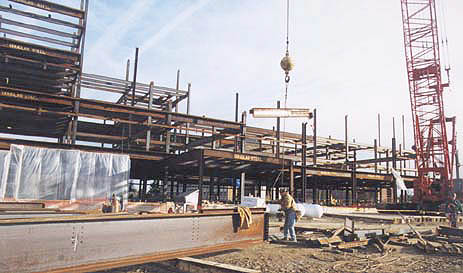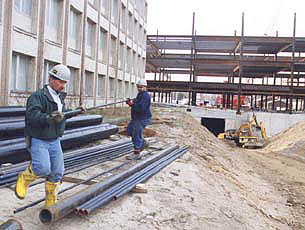Building will bring together MSU's spread-out scientists
Date Posted: January 21 2000
EAST LANSING - Perhaps the most important reason for construction of the Biomedical and Physical Sciences (BPSC) building on the Michigan State University campus is that it will put scientists from different disciplines under one roof.
One very big roof.
Construction is moving along well on the six-story, 370,000-square-foot building, which will be the largest classroom buildings on the MSU campus. General contractor Chrisman, its subcontractors and the building trades began work last spring, and the project is expected to wrap up in December 2001.
The $93 million building will put biologists and physicists under one roof, housing the Departments of Microbiology, Physiology, and Physics and Astronomy, as well as the Center for Microbial Ecology and the Center for Sensor Materials. The structure replaces the demolished Biology Research Center, and will connect the existing Chemistry Building to the existing Biochemistry Building, creating a major science complex as well as a single building.
It won't be your run-of-the-mill office building.
"It will be a teaching and research facility, so the building will house quite a variety of specialized equipment," said Doug Norton, project manager for Chrisman. "We'll be installing labs with medical gas, natural gas, nitrogen, compressed air, distilled water - quite a variety of piping and equipment. The project requires immense coordination to keep things moving smoothly."
Last week, structural steel had been erected to the fourth floor, the concrete basement walls were being finished, and the trades were taking care of mechanical and electrical rough-ins.
The building will house laboratories, offices, classrooms, a "clean" room and a large atrium, which will have lounges and conversation areas designed to informally bring students, faculty and scientists together.
University Provost Lou Anna Simon said "that kind of human interaction is extraordinarily important to science. This building will permit many people from different backgrounds to bump into one another, have casual but significant hallway conversations - the sharing of ideas about issues and concerns that are now confined to conversations within disciplines or divisions."
The buildings that are being replaced are rich in scientific history - with pioneer work in cyclotron design, infectious diseases, cancer/hormone relationships, and orthopedic surgery - but they're showing their age. Giltner Hall, home to the microbiology and physiology departments, was built in 1913. The Physics-Astronomy Building went up in 1949.

IRON WORKERS at MSU construction site for new Biomedical and Physical Sciences building.

PLUMBERS at MSU construction site for new Biomedical and Physical Sciences building..
